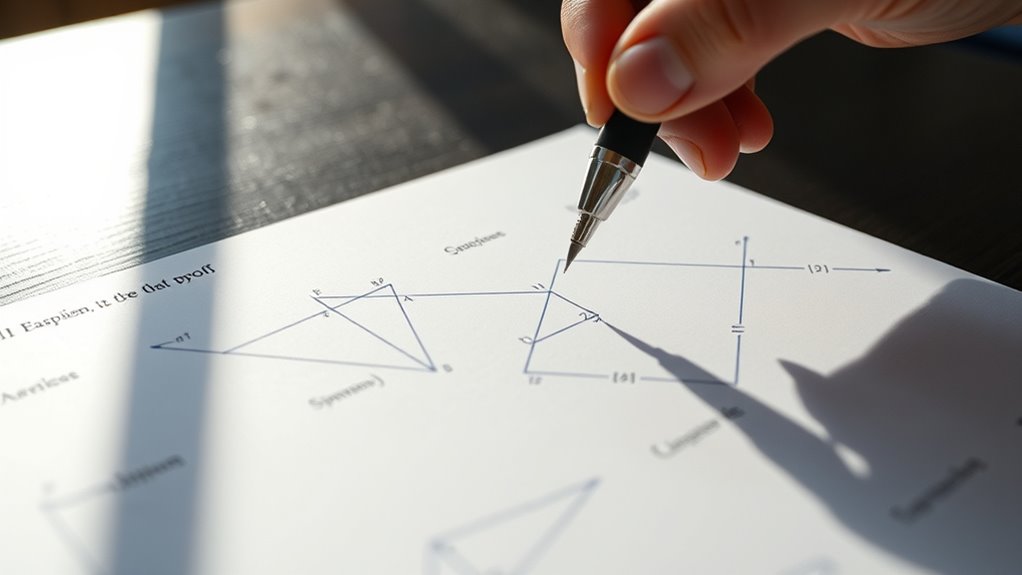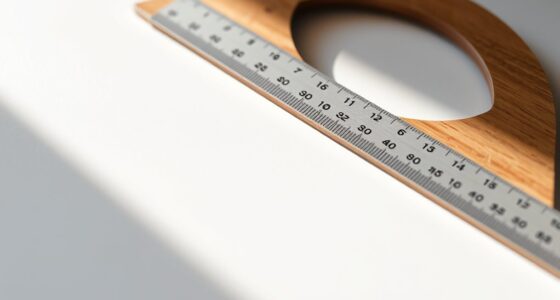To become a logic ninja fast in geometric proofs, focus on mastering angle chasing and understanding congruence criteria like SAS or ASA. Use diagrams to label all angles clearly and follow a logical sequence of deductions. Recognize relationships like parallel lines or equal angles to guide your reasoning. Practice these techniques regularly, and you’ll find complex proofs becoming straightforward step-by-step puzzles. Keep exploring, and you’ll soon discover the secrets to clear, confident proofs.
Key Takeaways
- Master angle chasing to identify equal angles and relationships quickly in geometric diagrams.
- Use congruence criteria (like SAS) to confirm triangle equality and simplify proofs.
- Break down complex proofs into clear, logical steps following a structured sequence.
- Leverage properties of parallel lines and transversals to establish key angle relationships.
- Practice organizing diagrams and applying theorems regularly to build confidence and speed.

Understanding geometric proofs can seem challenging at first, but they become much clearer once you recognize their fundamental strategies. One of the most effective techniques you’ll want to master is angle chasing. This involves logically following the flow of angles through a figure, identifying relationships, and making deductions based on known properties. When working through a proof, start by labeling all angles clearly, noting which are given and which need to be proven. Then, look for opportunities to connect angles by recognizing when two angles are equal, supplementary, or complementary. Angle chasing helps you keep track of these relationships, making it easier to see how different parts of the figure relate.
Master angle chasing to uncover relationships and simplify geometric proofs.
In addition to angle chasing, understanding congruence criteria is essential. Congruence criteria tell you when two triangles or segments are equal in shape and size, which is a cornerstone of many proofs. For example, if you can identify that two triangles share a side and have two angles equal, you might apply the SAS (Side-Angle-Side) criterion to establish their congruence. Recognizing these criteria allows you to transfer properties from one part of the figure to another confidently. As you work through proofs, always ask yourself which criteria can be applied—are two triangles sharing a side? Do they have two angles and a side equal? Using these criteria systematically simplifies the process and helps you build a logical chain.
When you combine angle chasing with congruence criteria, you gain a powerful toolkit. For instance, you might start by chasing angles to find equal angles, then use those equal angles to identify congruent triangles. Once you establish triangle congruence, you can confidently assert that corresponding sides are equal, which often leads to the conclusion you’re trying to prove. This step-by-step approach keeps your proof grounded in solid logic, reducing guesswork and increasing clarity.
Additionally, understanding the importance of geometric properties like parallel lines and transversals can significantly aid in your proofs, as they often create angle relationships that are key to your deductions. Practicing these strategies will train you to think like a geometric detective, carefully piecing together clues in the diagram. The key is to stay organized—label everything, note your assumptions, and methodically apply theorems. Over time, angle chasing and congruence criteria will become second nature. As you sharpen these skills, you’ll find that what once seemed complex now feels straightforward. With patience and practice, you’ll develop the confidence to approach any geometric proof with precision, turning what once felt like a puzzle into a logical sequence of steps.
Frequently Asked Questions
How Can I Improve My Geometric Proof Writing Skills Quickly?
To improve your geometric proof writing skills quickly, focus on mastering proof strategies and enhancing your logical reasoning. Practice analyzing problems step-by-step, clearly stating your assumptions, and using diagrams to visualize relationships. Study worked-out proofs to recognize common patterns, and challenge yourself with diverse problems. Consistent practice and reflection on your reasoning help build confidence, making your proofs clearer and more convincing in a shorter amount of time.
What Common Mistakes Should I Avoid in Geometric Proofs?
When working on geometric proofs, avoid common assumptions that aren’t justified, as they can lead to proof missteps. Don’t skip explaining each step clearly, and make certain your reasons align with the properties or theorems you’re using. Watch out for logical gaps, and double-check that your statements truly follow from earlier ones. By staying precise and avoiding unwarranted assumptions, you’ll strengthen your proofs and build confidence in your logical reasoning skills.
Are There Any Visual Aids to Help Understand Complex Proofs?
You ask if there are visual aids to help with complex understanding. Yes, visual aids like diagrams, color-coded figures, and step-by-step illustrations can make intricate proofs clearer. They help you see relationships and patterns more easily, making the logic behind the proof more intuitive. By using these tools, you can grasp complex concepts faster and reduce confusion, turning abstract ideas into visual, understandable elements that improve your overall comprehension.
How Does Geometric Logic Differ From Algebraic Logic?
You might wonder how geometric logic differs from algebraic logic. Geometric logic relies on visual reasoning and spatial visualization, helping you see relationships and proofs through diagrams and shapes. In contrast, algebraic logic uses symbols and formulas, focusing on abstract reasoning. By understanding these differences, you can choose the best approach for solving problems, making complex proofs more intuitive through visual tools or symbolic analysis.
Can Geometric Proofs Be Automated With Software Tools?
Did you know that automated theorem proving has increased by over 40% in recent years? Yes, you can automate geometric proofs using proof generation software, which helps verify the validity of geometric statements quickly. These tools analyze diagrams, generate logical steps, and provide proofs without manual effort. So, if you’re interested in efficiency, software for automated theorem proving makes geometric proof creation faster and more accurate than ever before.
Conclusion
Now you’re a nimble ninja steering neat niches of notation, knocking out knots of complexity. With confidence, you conquer convoluted concepts, carving clarity from chaos. Geometric proofs become your playground, painted with precision and power. Keep practicing, and you’ll propel yourself past perplexity, becoming a master of mirroring, matching, and matching. Embrace each elegant equation, energize your expertise, and enjoy the exhilarating evolution into a true logic ninja—ready to conquer any challenge with clever, crisp clarity.








